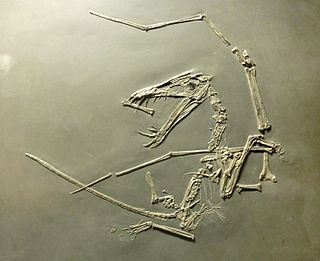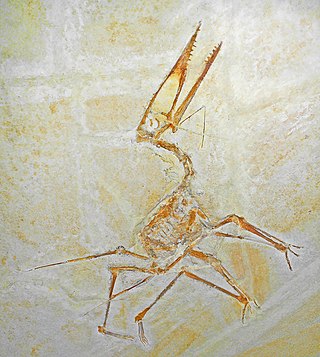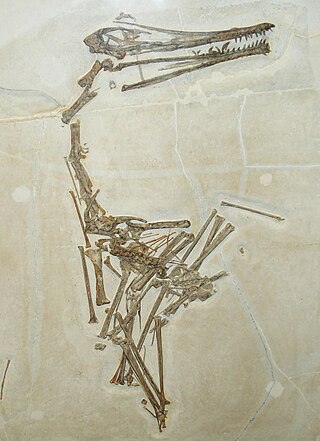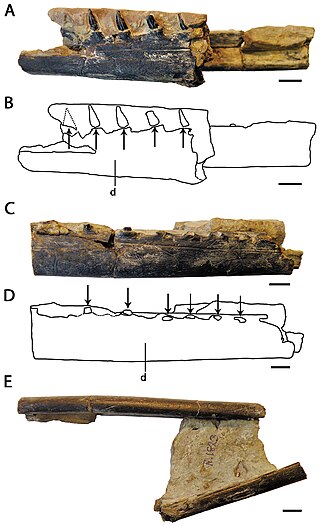
Pterosaurs are an extinct clade of flying reptiles in the order Pterosauria. They existed during most of the Mesozoic: from the Late Triassic to the end of the Cretaceous. Pterosaurs are the earliest vertebrates known to have evolved powered flight. Their wings were formed by a membrane of skin, muscle, and other tissues stretching from the ankles to a dramatically lengthened fourth finger.

Anurognathus is a genus of small pterosaur that lived during the Late Jurassic period. Anurognathus was first named and described by Ludwig Döderlein in 1923. The type species is Anurognathus ammoni. The specific name ammoni honours the Bavarian geologist Ludwig von Ammon, from whose collection Döderlein had acquired the fossil in 1922.

Ornithocheirus is a pterosaur genus known from fragmentary fossil remains uncovered from sediments in the United Kingdom and possibly Morocco.

Tropeognathus is a genus of large pterosaurs from the late Early Cretaceous of South America. This genus is considered to be a member of the family Anhangueridae, however, several studies have also recovered it within another family called Ornithocheiridae. Both of these families are diverse groups of pterosaurs known for their keel-tipped snouts and large size. Tropeognathus is regarded as the largest pterosaur found in the Southern Hemisphere, only rivaled by the huge azhdarchids. The type and only species is Tropeognathus mesembrinus. Fossil remains of Tropeognathus have been recovered from the Romualdo Formation, which is a Lagerstätte located in the Santana Group of the Araripe Basin in northeastern Brazil.

Dorygnathus was a genus of rhamphorhynchid pterosaur that lived in Europe during the Early Jurassic period, when shallow seas flooded much of the continent. It had a short wingspan, and a relatively small triangular sternum, which is where its flight muscles attached. Its skull was long and its eye sockets were the largest opening therein. Large curved fangs that "intermeshed" when the jaws closed featured prominently at the front of the snout while smaller, straighter teeth lined the back. Having two or more morphs of teeth, a condition called heterodonty, is rare in modern reptiles but more common in basal ("primitive") pterosaurs. The heterodont dentition in Dorygnathus is consistent with a piscivorous (fish-eating) diet. The fifth digit on the hindlimbs of Dorygnathus was unusually long and oriented to the side. Its function is not certain, but the toe may have supported a membrane like those supported by its wing-fingers and pteroids. Dorygnathus was according to David Unwin related to the Late Jurassic pterosaur Rhamphorhynchus and was a contemporary of Campylognathoides in Holzmaden and Ohmden.

Germanodactylus is a genus of germanodactylid pterodactyloid pterosaur from Upper Jurassic-age rocks of Germany, including the Solnhofen Limestone. Its specimens were long thought to pertain to Pterodactylus. The head crest of Germanodactylus is a distinctive feature.
Anhanguera is a genus of pterodactyloid pterosaur known from the Early Cretaceous Romualdo Formation of Brazil and the Late Cretaceous Kem Kem Group of Morocco. This pterosaur is closely related to Ornithocheirus, but belongs in the family Anhangueridae. The generic name comes from the Tupi words añanga, meaning "spirit protector of the animals" + wera "bygone".

Campylognathoides is an extinct genus of pterosaur discovered in the Württemberg Lias deposits of Germany; this first specimen however, consisted only of wing fragments. Further better preserved specimens were found in the Holzmaden shale; based on these specimens, Felix Plieninger erected a new genus.

Cycnorhamphus is a genus of gallodactylid ctenochasmatoid pterosaur from the Late Jurassic period of France and Germany, about 152 million years ago. It is synonymous with the genus Gallodactylus.
Dermodactylus was a genus of pterodactyloid pterosaur from the Kimmeridgian-Tithonian-age Upper Jurassic Morrison Formation of Wyoming, United States. It is based on a single partial bone, from the hand.
Rhamphinion is a genus of pterosaurs from the Sinemurian-mid Pliensbachian-age Lower Jurassic Kayenta Formation of northeastern Arizona, United States. The type species is R. jenkinsi.

Altmuehlopterus is a genus of pterosaur belonging to the Pterodactyloidea. It lived in the Late Jurassic of what is now Germany. It was formerly known as "Daitingopterus", a nomen nudum, informally coined in 2004.
Puntanipterus is a genus of pterodactyloid pterosaur from the Early Cretaceous period La Cruz Formation of San Luis, Argentina.

Santanadactylus was a genus of pterodactyloid pterosaur from the Albian-age Romualdo Member of the Upper Cretaceous Santana Formation, of Barra do Jardim, Araripe Plateau, Ceará State, Brazil. Four species have been named, but today are no considered congeneric with each other. It was a rather large pterosaur.
"Palaeornis" cliftii is a pterosaur species known from parts of a single humerus found in the early Cretaceous (Valanginian) of the upper Tunbridge Wells Sand Formation, England.
Apatomerus, is a genus of extinct reptile known from a single fossil from the Albian-age Kiowa Shale of Kansas, USA. This bone, collected in 1893, was first identified as the thighbone of a crocodilian, but was described in 1903 by Samuel Wendell Williston as belonging to a pterosaur. This identification held through the 1970s, but has been abandoned. Recent summaries of pterosaur genera, such as Wellnhofer, 1991 and Glut, 2004 did not include it, and Mike Everhart, an authority on the rocks of the Western Interior Seaway identifies the bone as more likely the upper part of a plesiosaurian propodial.
Rhabdopelix is a dubious genus of possible kuehneosaurid reptile, from the Late Triassic-age Lockatong Formation of Pennsylvania, United States. Based on partial, possibly chimeric remains, it was described by American naturalist and paleontologist Edward Drinker Cope as an early pterosaur. It held this status until the 1960s, when Ned Colbert reevaluated it for his description of Icarosaurus. He noted that the bones came from a block with the remains of other animals, and that Cope had misinterpreted some of the remains; for example, the rod-like "pubic bones" that had given it its name were actually much more like the bony structures used by Icarosaurus and related animals to glide. Additionally, he couldn't relocate the fossils, which are assumed to be lost. He recommended considering Rhabdopelix a dubious name. Peter Wellnhofer retained it as a pterosaur of unknown affinities in his 1978 review, but rejected this by 1991.

Ardeadactylus is an extinct genus of ctenochasmatoid pterosaur known from the Late Jurassic Solnhofen limestone of Bavaria, southern Germany. It contains a single species, Ardeadactylus longicollum, which was originally thought to be a species of Pterodactylus, as P. longicollum.

This timeline of pterosaur research is a chronologically ordered list of important fossil discoveries, controversies of interpretation, and taxonomic revisions of pterosaurs, the famed flying reptiles of the Mesozoic era. Although pterosaurs went extinct millions of years before humans evolved, humans have coexisted with pterosaur fossils for millennia. Before the development of paleontology as a formal science, these remains would have been interpreted through a mythological lens. Myths about thunderbirds told by the Native Americans of the modern Western United States may have been influenced by observations of Pteranodon fossils. These thunderbirds were said to have warred with water monsters, which agrees well with the co-occurrence of Pteranodon and the ancient marine reptiles of the seaway over which it flew.

Serradraco is a genus of Early Cretaceous pterodactyloid pterosaur from the Valanginian aged Tunbridge Wells Sand Formation in England. Named by Rigal et al. in 2018 with the description of a second specimen, it contains a single species, S. sagittirostris, which was formerly considered a species of Lonchodectes, L. sagittirostris. In 2020, Averianov suggested it did not belong in Lonchodectidae.












